Using contaminated surgical equipment poses significant risks of severe health complications for patients. Therefore, it’s imperative for medical practitioners to prioritize the cleanliness of instruments before commencing any procedure.
Indeed, the importance of cleaning surgical instruments cannot be overstated; it is as critical as ensuring the availability of proper equipment for a given procedure. Moreover, thorough cleaning and disinfection of medical equipment play a crucial role in minimizing the transmission of diseases from one patient to another.
Both surgical instrument processing technicians and surgeons themselves must possess a thorough understanding of proper instrument cleaning techniques. Additionally, they should be proficient in assessing whether an instrument has been adequately disinfected.
Manual cleaning:
Use lint-free cloth soaked in neutral pH detergent.
Prohibited: Wire brushes or abrasive tools (damage titanium alloy coating)
Sterilization Methods
| Method | Parameters | Lifespan Preservation |
| Low-temperature plasma | 135°C, 45 min, H₂O₂ concentration 6 mg/L | ★★★★★ (50 cycles) |
| Ethylene oxide (EtO) | 55°C, RH 60%, 4-hour exposure | ★★★★☆ (40 cycles) |
| Glutaraldehyde immersion | 2% alkaline solution, 10-hour immersion | ★★☆☆☆ (15 cycles) |

